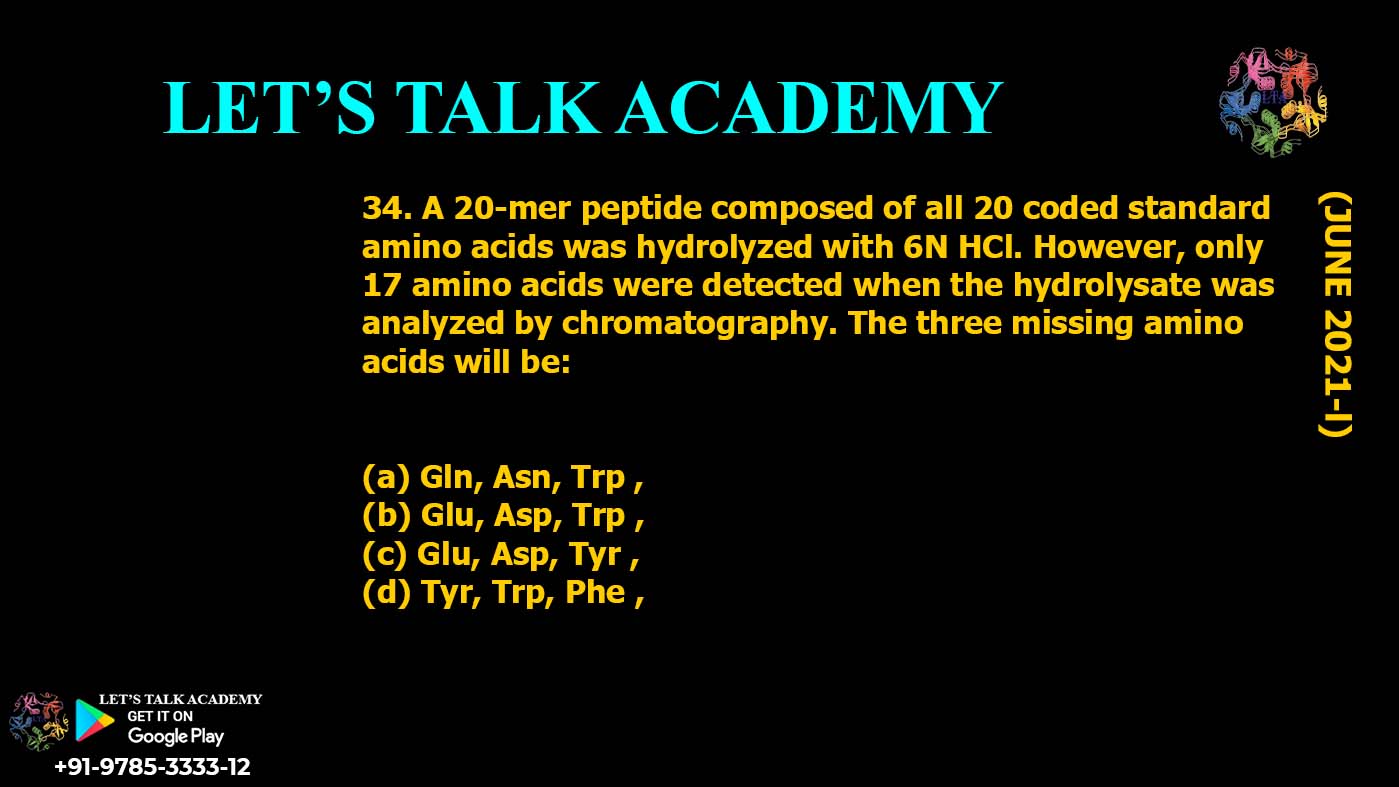34. A 20-mer peptide composed of all 20 coded standard amino acids was hydrolyzed with 6N HCl.
However, only 17 amino acids were detected when the hydrolysate was analyzed by
chromatography. The three missing amino acids will be:
(a) Gln, Asn, Trp ,
(b) Glu, Asp, Trp ,
(c) Glu, Asp, Tyr ,
(d) Tyr, Trp, Phe ,
Introduction
Peptide hydrolysis is a key step in amino acid analysis, where a peptide is broken down into its constituent amino acids using strong acids such as 6N HCl. This process is commonly followed by chromatographic techniques to identify the individual amino acids in the sample. However, sometimes, not all the expected amino acids are detected during analysis. In a scenario where a 20-mer peptide composed of all 20 standard amino acids is hydrolyzed and only 17 amino acids are detected, it’s important to identify which amino acids might be missing.
In this article, we will explain why certain amino acids, such as tryptophan, tyrosine, and others, may not be detected after peptide hydrolysis and chromatography, and which amino acids are likely missing from the analysis.
The Role of Acid Hydrolysis in Peptide Analysis
Peptides consist of chains of amino acids linked by peptide bonds. When a peptide is subjected to hydrolysis with 6N hydrochloric acid (HCl), the peptide bonds are broken, releasing the individual amino acids into the solution.
However, certain amino acids are more resistant to acid hydrolysis than others, which can result in them not being detected in chromatographic analysis. These amino acids typically have characteristics that make them more stable or less reactive under acidic conditions.
Common Amino Acids That Are Resistant to Acid Hydrolysis
-
Tryptophan (Trp):
-
Tryptophan is particularly susceptible to degradation during acid hydrolysis, especially under strong acidic conditions like 6N HCl. The indole side chain of tryptophan can undergo chemical changes that prevent its detection in chromatographic analysis.
-
-
Tyrosine (Tyr):
-
Tyrosine is also known to be sensitive to hydrolysis conditions. The phenolic group on its side chain can be altered during strong acid treatment, resulting in reduced or absent detection.
-
-
Cysteine (Cys):
-
Cysteine has a thiol group (-SH) that can react under acidic conditions, leading to the formation of cysteine derivatives that might not be detected in standard chromatographic analysis.
-
-
Asparagine (Asn) and Glutamine (Gln):
-
Asparagine and glutamine, both amide-containing amino acids, can undergo deamination under acidic conditions, which may lead to the loss of their characteristic properties or formation of products that cannot be detected using standard chromatographic methods.
-
Why Are These Amino Acids Missing?
The three missing amino acids in the hydrolyzed peptide are likely those that are most susceptible to chemical modifications or degradation during the hydrolysis process. Tryptophan (Trp), tyrosine (Tyr), and glutamine (Gln) or asparagine (Asn) are known to be particularly sensitive to acid hydrolysis and are likely the ones that were either altered or degraded, leading to their absence from the chromatographic analysis.
Conclusion
In the case where a 20-mer peptide composed of all 20 standard amino acids is hydrolyzed with 6N HCl and only 17 amino acids are detected, the missing amino acids are likely to be Tryptophan (Trp), Tyrosine (Tyr), and Glutamine (Gln) or Asparagine (Asn). These amino acids are known to be resistant to acid hydrolysis and can undergo chemical changes that prevent their detection in chromatographic analysis.
Answer:
The correct answer is:
(a) Gln, Asn, Trp.




10 Comments
Vikram
April 22, 2025Submitted
Pallavi gautam
April 23, 2025Okk
Neelam Sharma
August 30, 2025Tyrosine (Tyr), and Glutamine (Gln) or Asparagine (Asn). Are missing in chromatography because Hydrolysis me some amino acid destroy and change in other molecule so no seen pick in chromatography there are missing amino acid
Meera Gurjar
August 30, 2025Tyrosine, glutamine nd aspargine
Aakansha sharma Sharma
September 1, 2025Glutamine (Gln), Asparagine (Asn),Tryptophan(Trp)
Ajay Sharma
September 1, 2025Tyrosine tryptophan and glutamine are less affected by chemical treatment compared to others
Komal Sharma
September 1, 2025In the case where a 20-mer peptide composed of all 20 standard amino acids is hydrolyzed with 6N HCl and only 17 amino acids are detected, the missing amino acids are likely to be Tryptophan (Trp), Tyrosine (Tyr), and Glutamine (Gln) or Asparagine (Asn). These amino acids are known to be resistant to acid hydrolysis and can undergo chemical changes that prevent their detection in chromatographic analysis. So option B is correct
Soniya Shekhawat
September 5, 2025Done from explanation .
Soniya Shekhawat
September 5, 2025When peptides are hydrolyzed with strong acid:
Tryptophan (Trp) is destroyed.
Glutamine (Gln) and Asparagine (Asn) are converted to Glutamic acid (Glu) and Aspartic acid (Asp), respectively, so they cannot be detected in their original form.
So option a is correct. Missing a.a is Gln,Asn,Trp.
Khushi Agarwal
November 28, 2025Asn ,gln ,trp try